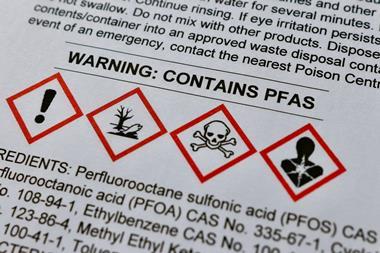The US Environmental Protection Agency (EPA) has proposed the first-ever nationwide drinking water standards in America for six members of a controversial class of chemicals known as per- and polyfluoroalkyl substances (PFAS). The agency anticipates finalising the regulation by the end of the year.
PFAS chemicals have unique properties that confer oil, grease and water repellence as well as resistance to high temperatures, which have led them to be used in the production of household items like non-stick cookware, raincoats, as well as in furniture as fabric protectors. But they do not degrade in the environment, are highly mobile and bioaccumulate.
The EPA will set limits for six PFAS, including perfluorooctanoic acid (PFOA) and perfluorooctanesulfonic acid (PFOS), which are two of the best known and studied of the estimated 12,000 PFAS compounds out there. They have been linked to health problems like high cholesterol, liver damage, immune system impairment, as well as fertility problems and cancer.
The agency is proposing drinking water limit for PFOA and PFOS of 4 parts per trillion (ppt) in water, which the agency describes as a level that ‘can be reliably measured’.
Last summer, the EPA issued stricter safety standards for four PFAS substances in drinking water, including for PFOA and PFOS, saying that these chemicals are more hazardous than had been realised. In June, the agency proposed adjusting exposure levels in drinking water from 70ppt to 0.004ppt and 0.020ppt for PFOA and PFOS, respectively. At the same time, the agency also announced that hexafluoropropylene oxide dimer acid and its ammonium salt, known as GenX, and perfluorobutane sulfonic acid (PFBS) would be subject to federal health advisories at 10ppt and 2000ppt, respectively.
‘Long overdue’
But in its latest action, the EPA is also proposing a binding limit for PFBS, GenX, perfluorohexane sulfonate (PFHxS) and perfluorononanoic acid (PFNA) based on a hazard index. This index would be used to assess whether combined levels of these four PFAS posed a danger to human health.
This is the latest move by the agency to address the problem of PFAS pollution, including its proposal in September 2022 to designate PFOA and PFOS as hazardous substances and thereby compel polluting companies to cover the clean-up costs.
Will Dichtel, an organic chemist who studies PFAS at Northwestern University, US, is very enthusiastic about the EPA’s new PFAS drinking water standards, and says the forthcoming regulation could ultimately be expanded to other members of this family of compounds. ‘These standards are long overdue, and I was pleased that PFOA and PFOS were set at low levels certainly and ones that I think are an appropriate balance between the fact that we should be tolerating none of these chemicals in our water and a realistic treatment standard – this is an excellent start,’ he says.
‘But even more surprising is the combined hazard index approach to the other four compounds, because that indicates a recognition that PFAS as a class are important,’ Dichtel continues. ‘It is really a framework that can be added to such that we can appropriately regulate the amount of PFAS in water as a combination of substances – I think that is exactly what we need.’
Jamie DeWitt, an associate professor of pharmacology and toxicology at East Carolina University, agrees. The EPA is making it clear that although PFAS vary in their structure and function, exposure to different compounds in this class can result in similar health effects and so are also likely to result in dose-additive effects, she explains.
Chemical industry challenge
‘There are different toxicities per chemical, but this cumulative approach means that they all pose toxicological effects and in combination their effects together are greater than their toxicological effects individually,’ DeWitt adds. ‘It is pretty amazing that the EPA is considering this approach for a regulatory standard because it is a step toward recognising that PFAS should be managed on a greater level than one chemical at a time – it is an important step to taking a group or class approach to managing PFAS in drinking water.’
Linda Birnbaum, a toxicologist and microbiologist who formerly headed the US National Institute of Environmental Health Sciences and the National Toxicology Program, is also encouraged that four specific PFAS can now be treated cumulatively. ‘There are a lot of other PFAS that we are finding in drinking water and in people, and the more that we can think about regulating these as a whole class I think the further we are going to get,’ she tells Chemistry World.
But the American Chemistry Council (ACC), which represents US chemical companies, is pushing back. The trade group noted that PFOA and PFOS were phased out by its members more than eight years ago. While ACC supports restrictions on the use of PFAS globally, it expressed ‘serious concerns’ with the underlying science that the EPA used to develop these proposed drinking water limits.
The organisation points out that the World Health Organization (WHO) seems to be at odds with the EPA. Back in late September, the WHO proposed its own provisional guideline drinking water values of 100ppt individually for PFOA and PFOS and 500ppt for total combined PFAS, which the agency said includes the roughly 30 PFAS types that can currently be measured reliably.













No comments yet